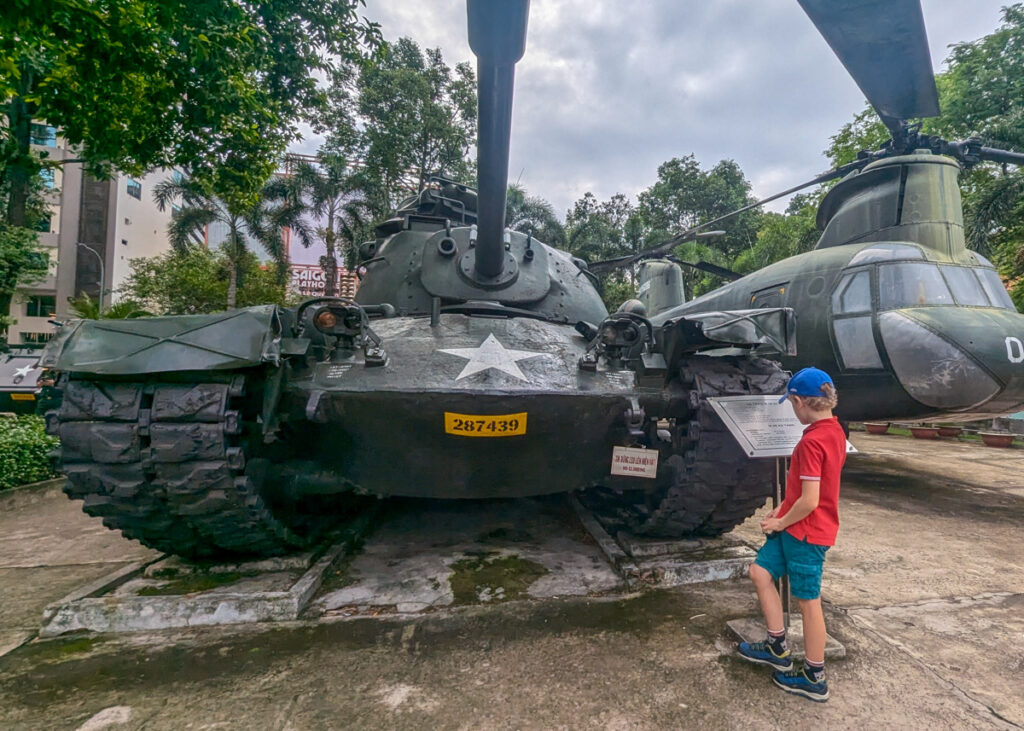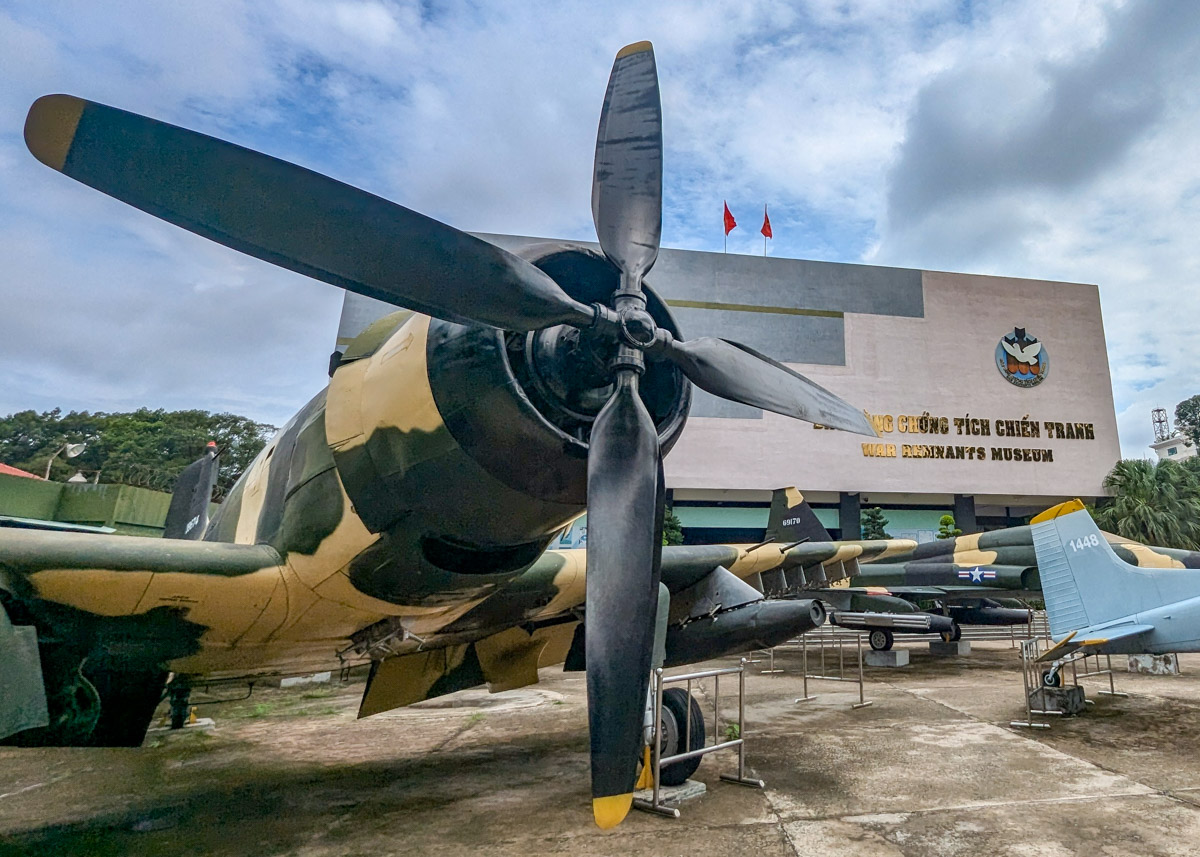Here we chat about what to expect when visiting HCMC’s War Remnant Museum with kids and whether a visit here is suitable with little ones.
Whenever we visit somewhere new with our boys, we’re always keen for them to learn something about the country and its history. In a place like Vietnam, where the tragic events of the twentieth century can still feel raw and relevant, a quick history lesson is required. To help with this, we decided to take the kids to the War Remnants Museum in Ho Chi Minh City. Whilst it’s not a place that shies away from the terror and consequences of war, it still manages to tell its story in a way which is accessible to (slightly) older kids, albeit with a few notable exceptions.
Do also make time to visit the Cu Chi Tunnels. The kids will love crawling through the tunnels and it’s a fascinating insight into how the American-Vietnam war was fought in the jungles. It’s one of our top things to do in HCMC with kids and you can visit the Cu Chi Tunnels without a tour.

Vietnam with kids travel guide
Your comprehensive guide to travelling Vietnam with kids, including accommodation suggestions and an itinerary, from a family that spent 45 day overlanding from HCMC to Hanoi.
Arriving to the museum
The War Remnants Museum is located in the centre of HCMC, within walking distance of many of the other sights in the city including the cathedral and the Independence Palace. If you’re already in the city centre (and it’s not too hot), you can walk here, otherwise jump in a Grab taxi.
On a side note, you may need to politely decline the efforts of an annoying (but relatively harmless) coconut seller who operates a minor scam on tourists walking towards the entrance. Just say ‘no thanks’ to any offers of free photos or free coconut tasting and you’ll be fine.
The museum is cash only. There are a few ATMs within walking distance if you’re caught short, but try to bring cash with you if possible.
Queues don’t tend to be too bad and there’s plenty of space in the forecourt once you get inside. If you spot a tour group arriving in a fleet of buses, try to get into the queue before them or instead hang back and let them shuffle through ahead of you.

Opening times and cost
Ticket price is VND30,000 per person with no reduction for kids. As noted above, payment is cash only.
The museum is open from 7:30am to 5:30pm. Try to arrive early or late in the day to avoid the heat and tour-groups.
You can pay extra for an audio guide but during the visit you’re likely to be fielding questions from the kids, so will need to be headphone-free. There aren’t any child-friendly versions of the audio guide.
The outdoor area
Once you’ve paid your entrance fee and gone through the rickety turnstiles, you enter a large outdoor area filled with a well-preserved array of military weapons and flying machines, all in surprisingly good condition.
Kids will find it all interactive and intriguing, with rocket-launchers, machine guns, tanks, attack helicopters and fighter jets on full display with little in the way of barriers or screens blocking access. It’s quite poignant to see these American-built machines parked up and seemingly untouched since the day they were captured.

To the left is a bleak indoor area which gives you the first taste of the human impact of the war, with guillotines and tiger cages (tiny cells used by the French to hold prisoners in horrendous conditions).
You’ll see several photos in this section which graphically depict the after-effects of both a guillotine execution and torture sessions. This is the first time you’ll need to exercise some caution if you’re visiting with younger kids, although there is space and time to make a judgement once you’re inside; none of the photographs are front and centre, but instead (mostly) tucked away in corners.
This area is more focused on Vietnamese independence fighters during the first Indochina War with the French. For understandable reasons, this section (and the museum in general) is very much presented from the perspective of the Vietnamese fighters. This gave us a good opportunity to discuss with the boys the subject of propaganda and how different sides come to view and (re)write history.
On that note, keep in mind that here (and in most of the rest of the country), the events of the 1960’s and 1970’s are referred to as the American War, not the Vietnam War.
Inside the War Remnants Museum
You’ll be grateful for the air-conditioning once you enter the main part of the museum, which is made up of three levels. We’d suggest heading up to the top level first (Level 2) and then making your way downwards. There’s more AC here and the displays are arguably better suited to children.
Level 2 is mainly devoted to photographs of the war that help explain and narrate the events. Our two boys found this area interesting as we wandered along picking out images which triggered questions and discussions. In particular, our ten-year old asked us why so many people volunteered to be photographers in such a dangerous situation. The photos are occasionally graphic and/or distressing but, if you stay one step ahead, it’s easy to shepherd the kids past the worst examples.

Also on Level 2, you’ll find more weaponry on display, from bullets, mortar rounds, machine guns and bayonets. It’s a good contrast from the outdoor display downstairs and focuses more on combat in closer quarters. The photographs you’ve just been looking at will help provide more context to the damage these weapons can cause.
Finally, there’s an excellent section on the pre-Independence days and the battles with the French colonialists. These displays explain in detail how the early Independence leaders (including Ho Chi Minh himself) took the battle to the French and the consequences for both sides. Again, this is largely told from a Vietnamese perspective but we still found it interesting as we took in the various photos and displays.
If you’re travelling with much younger kids, perhaps under-7’s, you might be grateful for the children’s education zone / play area on Level 2. This is a welcome and relaxing space for parents and younger kids to retreat to, particularly useful if one or more of your group decides to continue exploring the museum whilst others take some time out.

Heading downstairs to Level 1, you’ll need to decide how much of the increasingly confronting material you choose to expose your kids to. The content and displays here are several degrees more gruesome and upsetting than upstairs, including preserved foetuses of Agent Orange victims and photos of the effects this chemical had on the population who were alive when it was deployed. It makes for highly unpleasant viewing; we kept our youngest outside but our eldest was genuinely interested in what had happened, so we allowed him to view everything with no problems afterwards.
On the ground floor, there’s slightly less to see but you will find a shop and café. After the full-on experience on the upper two levels, now might be the time to exit via the outdoor display area. It’s interesting to discuss as a family, after witnessing all the displays inside, whether these machines of war seem quite as exciting and glamourous as they did an hour ago?
Is the HCMC War Remnants Museum suitable for kids?
This is a difficult question to answer and depends to a large degree on the age of your kids and their own capacity to process often gruesome imagery. What is without doubt is that the War Remnants Museum is an important place to visit to help the whole family understand the impact these wars had on the Vietnamese population.
Depending when you visit, it can be very hot outside when you first arrive, and there isn’t much shade as you wander around. Once inside, the AC kicks in and makes for a comfortable visit (in terms of temperature at least).
The museum is heavily based around photographs in the indoor sections, but there are plenty of real-life exhibits to look at. It’s an interactive museum in that sense, albeit not in the way you might be used to. It probably goes without saying but, if you’re not keen on your kids being exposed to lots of weaponry, bombs, bullets and guns, this isn’t the place for you.
As a general guide, if your kids are aged eight-plus, there will definitely be enough to make the visit worthwhile. With older kids, the museum becomes more fascinating and will help to put war into perspective for them.

How long should you spend at the HCMC War Remnants Museum with kids
One or two hours is plenty of time here. It’s not a huge museum and the kids might start to tire from the photos and displays after a while. On top of this, the material is almost universally confronting and challenging, so even adults might need a break after a couple of hours.
Final thoughts on visiting the HCMC War Remnants Museum with kids
Despite the great changes over the past few decades, the events of 1945 to 1975 continue to have an impact on the psyche of this beautiful country, so the War Remnants Museum is a valuable place to visit, especially if your knowledge of this era has mainly come from American films and literature.
The anti-French and (particularly) anti-American message is a constant theme throughout your visit, never trying to shy away from the destruction the two wars unleashed on Vietnam and the surrounding countries. The museum doesn’t pretend to present a balanced or unbiased view of the wars, so keep in mind that your kids might need some help putting everything into context. At times, the photographs and displays are intentionally graphic and upsetting, so you’ll be kept busy during the visit, often slipping ahead to check what’s around the next corner. It’s not the sort of place you’ll want your kids running around on their own.
If you do navigate the museum without any distress, you’re guaranteed to leave with a newfound understanding, sadness and respect for what the Vietnamese people went through. It’d be wrong to say you and your kids will enjoy it, but it’s impossible not to recommend a visit.
You may also like to read:
Ho Chi Minh City with kids: top 12 things to do in and around the city
10 day South Vietnam itinerary
Visiting Cu Chi Tunnels without a tour

